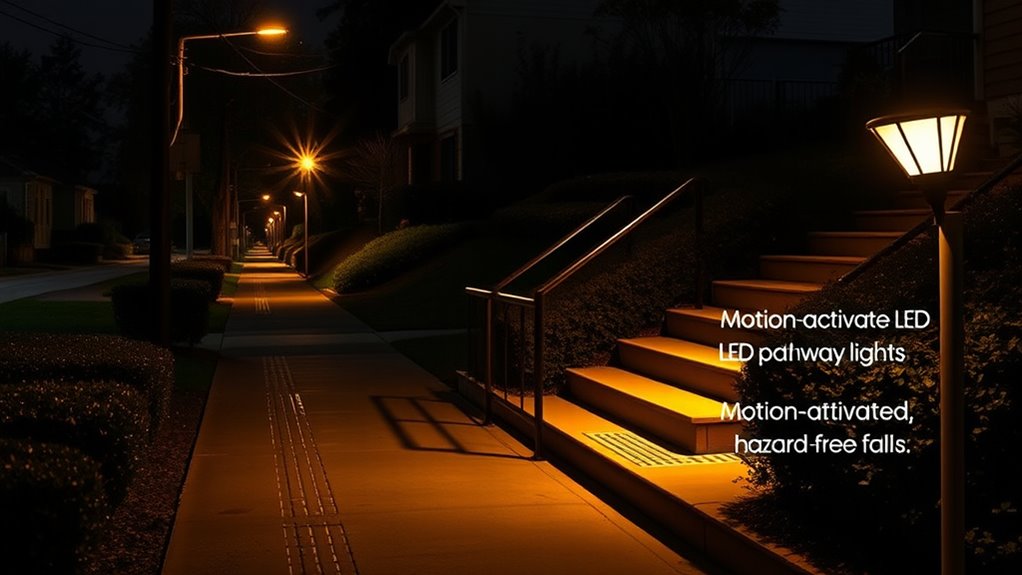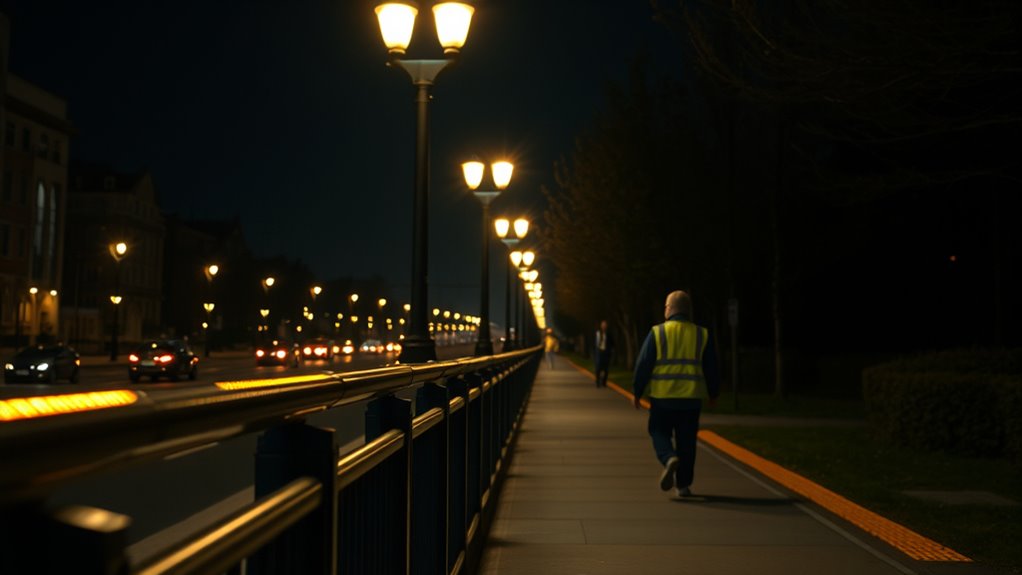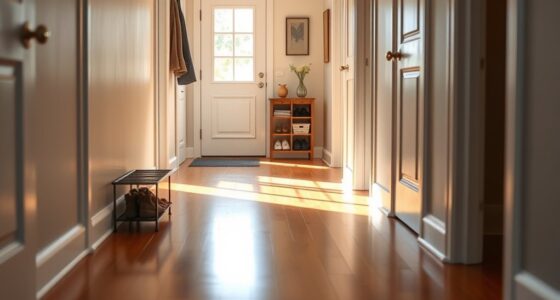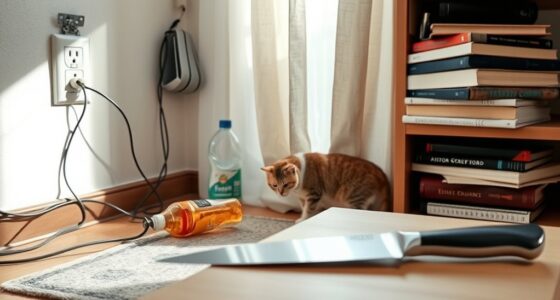To prevent nocturnal falls, guarantee your environment is well-lit with small, easy-to-reach lamps or nightlights near key areas like your bathroom and hallway. Clear pathways of clutter and secure rugs with non-slip pads to reduce trip hazards. Keep essential items within easy reach, and consider installing grab bars for added support. Wearing non-slip slippers and adjusting lighting levels can boost confidence. Continue exploring ways to create a safer sleep space that keeps you secure at night.
Key Takeaways
- Install easy-to-reach, low-intensity nightlights near pathways, bathroom, and bedroom doors to improve visibility without disturbing sleep.
- Keep walkways clear of clutter, loose rugs, and obstacles, and secure rugs with non-slip pads to prevent trips and falls.
- Use non-slip slippers and install grab bars or handrails in critical areas for added stability during nighttime movement.
- Ensure bedding is smooth and well-arranged to avoid tripping hazards and promote safe, confident bed exits.
- Regularly inspect the environment for hazards, and adjust lighting levels to balance safety and restful sleep.

Have you ever wondered how to stay safe when the sun goes down? One of the simplest and most effective ways is by paying attention to your bedside lighting. Proper bedside lighting ensures you can see clearly when you get out of bed, reducing the chances of accidents. If your room is too dark, you might stumble over furniture, rugs, or other obstacles, especially during nighttime trips to the bathroom or when you wake up suddenly. Installing a small, easy-to-reach lamp or using motion-activated lights can make a considerable difference. These lights allow you to navigate your space safely without turning on bright overhead lights that could disturb your sleep cycle. Keep the lighting at a level that provides enough visibility but isn’t so bright that it disrupts your rest. Avoid relying solely on harsh or overly bright lights, as they can cause disorientation and make you more prone to falls.
Sleep hazards are another key concern when it comes to nighttime safety. Many hazards are hidden in plain sight, like loose rugs, cluttered pathways, or slippery floors. Before you go to bed, take a moment to clear your path and ensure nothing could cause you to trip or fall. Check that your rugs are secured with non-slip pads, and move any clutter away from walkways. It’s also wise to keep essential items like a glass of water, your phone, or medications within easy reach so you don’t have to stretch or search for them in the dark. Use nightlights in strategic areas—near the bathroom, hallway, and your bedroom door—to provide enough illumination to see potential hazards but not so much that it disturbs your sleep. If you have mobility issues or are prone to balance problems, consider installing grab bars or handrails in critical areas to assist with stability. Incorporating Glycolic acid into your skincare routine can also help improve skin texture, making the skin more resilient to minor injuries from falls.
Another sleep hazard to watch out for is your bedding. Make sure your sheets and blankets aren’t bunched up or hanging off the bed, which could cause you to trip when getting in or out of bed. Wear comfortable, non-slip slippers if you need to walk around in the dark, especially on smooth or slippery surfaces. These small precautions greatly reduce your risk of nocturnal falls, which can lead to serious injuries. Remember, the goal is to create a safe, well-lit environment that allows you to move confidently during the night. With just a few simple adjustments—like strategic bedside lighting, clearing hazards, and using nightlights—you can substantially improve your nighttime safety and enjoy restful, worry-free sleep.
Frequently Asked Questions
How Can I Improve Sleep Quality to Reduce Fall Risk?
You can improve your sleep quality and reduce fall risk by practicing good sleep hygiene, like maintaining a consistent sleep schedule and creating a comfortable, dark environment. Incorporate relaxation techniques such as deep breathing or meditation before bed to calm your mind. Avoid screens and caffeine close to bedtime. Better sleep helps you stay alert and balanced at night, lowering the chances of falls.
Are There Specific Lighting Types Best for Nighttime Safety?
You should opt for motion-activated lighting with LED pathway illumination, as it provides bright, consistent light without needing to fumble for switches. This type of lighting instantly turns on when you move, reducing fall risks during nighttime visits to the bathroom or kitchen. The LED bulbs are energy-efficient and long-lasting, ensuring safety and convenience. Installing these lights creates a well-lit path, giving you confidence and reducing hazards in the dark.
What Are the Best Footwear Options for Nighttime Mobility?
You should choose slip-resistant shoes with cushioned insoles for nighttime mobility. These shoes provide better grip on smooth or potentially wet surfaces, reducing the risk of slips and falls. Cushioned insoles offer comfort and support during late-night movements, helping you stay steady. Opt for shoes with good traction and comfortable fit, ensuring you can move confidently and safely around your home or outdoors at night.
How Do Medication Side Effects Influence Fall Risk at Night?
Medication interactions and side effect management can subtly influence your balance at night, increasing fall risk. You might feel more unsteady or drowsy, which makes maneuvering in low light a challenge. To reduce this risk, consult your healthcare provider about your medications, and follow their advice carefully. Staying alert to how side effects affect you helps you adjust routines or medications, keeping your nighttime movements safer and more secure.
Can Environmental Modifications Prevent Falls During Late Hours?
Yes, environmental modifications can greatly prevent falls during late hours. You should ensure your home safety by installing night lights, removing clutter, and securing loose rugs. Keep pathways clear and add non-slip mats in bathrooms and hallways. By making these adjustments, you reduce hazards and support fall prevention, especially when visibility is low. These proactive steps help you stay safe and avoid nighttime accidents effectively.
Conclusion
By taking simple steps like installing nightlights, keeping pathways clear, and using sturdy footwear, you can greatly reduce your risk of nocturnal falls. Some might think these measures are unnecessary, but imagine stumbling in the dark and injuring yourself — it’s a risk you don’t want to take. Prioritize your safety tonight and every night by making small changes; they’ll give you peace of mind and help you wake up feeling secure.









